[Shwe Man Thabin performs a Zat Pwe program at Asia Society.]
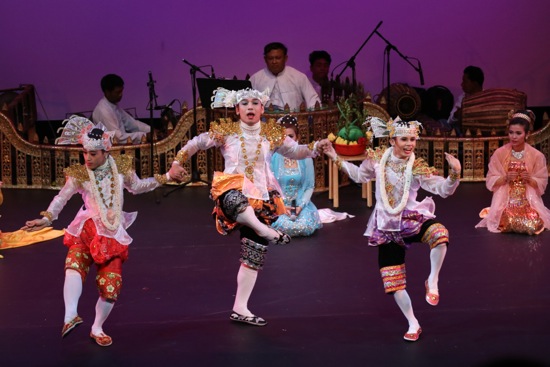
(L to R): Ye Yin Htet, Tin Maung San Min Win, and San Min Aung in the final portion of the Shwe Man Thabin troupe’s Asia Society program. Behind them: Thiri Maung Maung, leader of the music ensemble. Photo: E.H. Wallop
One of the many things that struck me about the splendid exhibit Buddhist Art of Myanmar (at Asia Society through May 10) is the smile on the face of the many statues of Buddha on display. It’s a smile you sometimes see on dancers in traditional South Asian forms; no teeth are visible, and the slightly upturned corners of the mouth suggests a secret happiness, whose source you would very much like to discover. It appears on humble forms, elegantly simple ones, and ornate ones in gilded pagodas.
One of the events connected with the exhibit was the zat pwe program presented at the Asia Society by some of the members of Shwe Man Thabin, a company from Myanmar (once known as Burma). The ten performers smile less secretive smiles; they flirt charmingly with the audience when delighted with their dancing or at one another when no trouble is afoot. The current company continues the tradition of Shwe Man Tin Maung, who founded the group in 1933. Influenced by the Broadway musicals he saw on a trip to the U.S. and dances that the Martha Graham Company presented when it toured Asia in 1955, he set about trying to introduce elements that would make people of all social classes become interested in traditional Burmese music, dance, and theater. He clearly succeeded. A slide shown during a pre-performance lecture by Kit Young (co-founder and artistic advisor of the Gitameit Music Center, a musician and performer herself), showed immense swarms of people following a funeral procession down a street in Yangon in 1969; Shwe Man Tin Maung had died onstage toward the end of a zat pwe.
A traditional zat pwe performance takes place out of doors, perhaps as part of a pagoda festival and lasts all night, with a break around 3 A.M. Its ambience is that of a vaudeville performance, but one whose acts are bound together by the country’s various stylistic traditions, even while venturing away from these. Watching Shwe Man Thabin’s zat pwe (condensed into about two hours including an intermission) is like coming upon a mini-banquet of different related forms—from bawdy folk dramas to elegant dances with religious significance (and all that lies between). Dancing! Singing! Comedy! Drama! Performers adept at all of these! And, supporting them, the Hsaing Waing—a musical ensemble led by Thiri Maung Maung and consisting of an array of drums, cymbals, and gongs, plus a hne (a double-reeded instrument akin to an oboe).
The music is astonishing—a complex clamor that can change from one quality to another, seemingly in midstream. The musicians underscore the performers’ rhythms at times, insert pauses for emphasis, mimic the quality of the steps. At times, the hne (played by master musician Ne Lin), raises its nasal melodies above gorgeous musical cataclysms. You’d think there were fifty musicians onstage, and the microphone that singers pass around can barely match that volume.
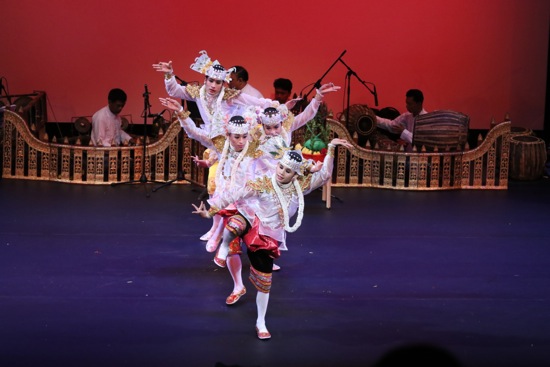
Front to back: San Min Aung, Ye Yin Hteh Aung, Chit Swun Thar,
and Awra Aung of Shwe Man Thabin. Photo: E.H. Wallop
Traditional Burmese dance is related to those of India and Thailand in terms of style, as are its religions, but it has its own fascinating characteristics, which have endured through British rule, World War II, and a military government that controlled life and art from 1962 until 2011. When in fluid motion, the dancers present their bodies as a festival of angles, created at almost every major joint: hips, knees, ankles, elbows, wrists. Their knees are almost always bent, their feet flexed and turned out. They dance on their knees as well as on their feet. Often, they circle their arms in opposing paths so the elbow of one arm is high and that of the other one low. Their hands make their own small circles, and their supple fingers bend back to create half moons. In the last part of the program, a virtuosic solo display by Tin Maung San Man Win (the co-director of the presentation) includes a moment when he forces one index finger back far enough to touch his wrist (the audience utters something between a gasp and an “ugh!”).
The jakata tales—which focus on Buddha’s prior incarnations, his achievements, and his beliefs— originated in India’s Theravada Buddhism before the Christian era, and for centuries were enacted by marionettes. You can see that in the dance style, envisioning an unseen puppeteer pulling up an elbow or a knee. And the performers often end their dances by dropping to the floor in a pose, as if imaginary strings have been released. At Asia Society, Saw Yu Nwe makes a marionette about sixteen inches tall dance, while an identically costumed dancer, the gifted young male dancer San Min Aung performs in unison or in dialogue with the smaller version of himself. To make sure we get the point, the puppeteer abandons her puppet temporarily to pantomime pulling on the dancer with invisible strings.
Several kinds of virtuosity appear on the program. Tin Maung San Man Win, in the above-mentioned solo (described in the program as contemporary) tucks up his longyi the better to display his jumps into a squat or a sit, his cartwheel, and other vigorous steps. He sings during the solo too. He and the other men performing are labeled as minthas (princes or male performers), while the women are minthamees. One of the latter, Shwe Joe Jar, executes a solo whose title translates as “The Flicking of the Htamein Skirt’s White Train Dance.” She’s dressed all in white in a garment that’s very long in back. Stepping elegantly, turning, swaying, bowing, and weaving the air with her hands, she has to keep kicking one foot or the other back and slightly to the side in order to flick the fabric away so she won’t step on it. She keeps her knees together, so that when she increases her speed, you see a narrow silhouette with a little storm of fabric foaming up around it at the bottom.
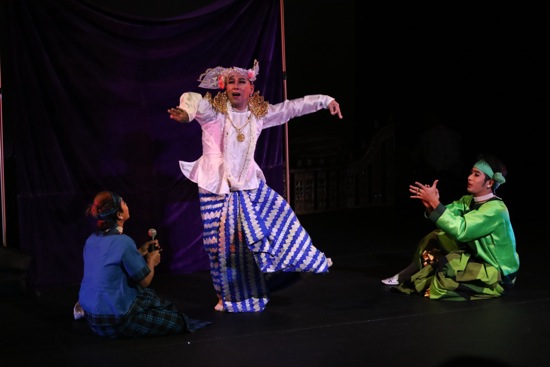
Shwe Man Chan Thar makes his first appearance in “The Royal Duet in a Sylvan Setting.” Watching him: Chit Swan Thar (L) and Awra Aung. Photo: E.H. Wallop
Comedy has its virtuosic aspect too. Shwe Man Chan Thar (a co-director of the troupe) performs with gusto and superb dramatic timing both the mintha and the minthamee roles in “The Royal Duet in a Sylvan Setting.” The characters apparently never meet. Nor does the dignified title give a clue to what actually happens. Shwe Man Chan Thar—handsomely dressed in a white silk jacket that wings up at its hem, a blue-and-white longyi, golden jewelry, and the traditional headwrap that fans out at one side—appears from behind a small purple curtain. His audience, in addition to us, are the group’s mintha comedy team, Chit Swan Thar and Awra Aung, seated onstage and conveying raucous excitement about what they’re about to see. When the soloist wants to talk, he grabs the one microphone from one of them and hands it back when he’s finished talking.
When he disappears behind the curtain again, the two country bumpkins keep us entertained—peeking under the concealing drape, imitating the soloist, and so on; they mime the familiar code for “a hot babe,” outlining a bust and hips. When Shwe Man Chan Thar reappears after a very quick assisted costume change behind a purple drape, he has become a scolding female, not so accidentally stepping on Awra Aung’s tender crotch. Jokes about passing gas are also part of the show. Over the course of this act, the main performer changes attire five times, becoming more and more disheveled and (shockingly!) immodest in his female persona.
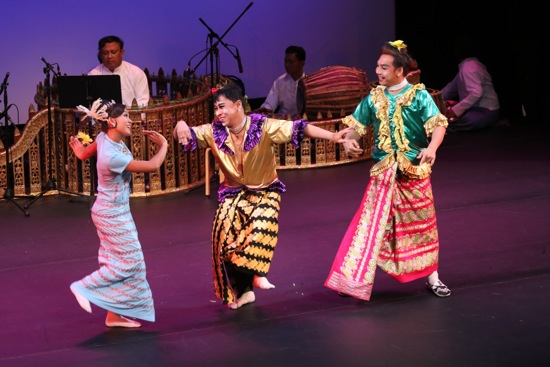
(L): San Shwe Sin, the maiden for whom Shwe Man Chan Thar (center) and Tin Maung San Min Win compete. Photo: E.H.Wallop
The jokes easily cross cultural boundaries. In one scene, a man from an Eastern village (Shwe Man Chan Thar) and one from a Western one (Tin Maung San Min Win) fight over a flirtatious young maiden from a Central village (San Shwe Sin); they charge in to grab her and end up hugging each other. In an unscheduled trio in the second part of the show, a narrator tells us in English that at one time in Myanmar, young men and women could not hold hands in public. Using naturalistic acting and talking, Chit Swan Thar demonstrates to his not-so-smart buddy, Awra Aung, a way to get around this problem; they and the object of their desire (Shwe Joe Jar) end up in a standing tangle, in which the foot that Awra Aung is holding up so gleefully is not that of the woman but that of the other guy. And it smells very bad.
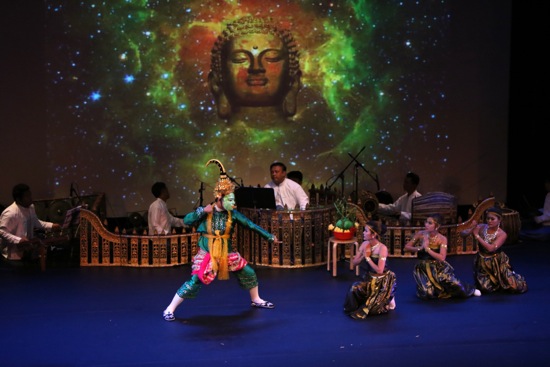
The evil Mara (Tin Maung San Min Win) orders his daughters to disrupt Buddha’s search for enlightenment. (L to R): Saw Yu Nwe, San Shwe Sin, and Shwe Joe Jar. Photo: E.H. Wallup
There’s no talking in the extract from a music drama by the company’s founder, Shwe Man Tin Maung, based on one of the jataka tales. A slide showing the giant head of Buddha is projected onto the backcloth behind the seated musicians. Enter the three daughters of Mara, the King of Evil, whose most fervent desire is to tempt Buddha away from enlightenment. Mara (Tin Maung San Min Win) wears a green demon mask and a vividly colored costume that enables him to take wide, aggressive stances. With fierce gestures, he orders one reluctant daughter (Saw Yu Nwe) to distract Buddha with her charms. She tries, but staggers away, holding her head as if she has butted against an actual wall and not just Buddha’s powerful concentration. Daughter #2 (San Shwe Sin) at first refuses the command, but ends up trying to fog Buddha’s mind with scent (she lets us know this by smelling her fingers and waving them); she too ends with a headache. When the more extended solo by daughter #3 (Shwe Joe Jar) fails to entrap Buddha, the evil king sets all of them to helping him pull invisible ropes, imagining that strength could topple the hero as if he were a statue in a village square. No luck; all four acknowledge the inevitable and pray to their erstwhile victim.
The second part of the evening continues to blend the traditional with the contemporary, moral lessons with low comedy, and choreographed dances with improvisation—but now in a non-stop celebration. We’d been told a bit of hip-hop might be on view, but it wasn’t missed, although the expert haing waing musicians were able to drop an occasional rock beat into the terrific music that shifts with every changeable cultural breeze.
If many of the performers’ names (including that of the young Ye Yin Htet Aung) seem similar, it may be because a number of them are related. The male contingent of the troupe includes brothers and a grandson descending from the company’s founder. Two of the players in the musical ensemble are sons of its leader Thiri Maung Maung. Shwe Man Win Maung, who has sung earlier in the evening (and now lives and teaches in New York City), tells us a little of the background of the material, as does the brilliant Tin Maung San Min Win, who has performed on six tours to the U.S.
In one of the evening’s last acts, those two join Shwe Man Chan Thar and San Min Aung in a mintha dance. Unwrapping part of their draped skirts, they criss-cross the ends of the fabric until the men are dancing bound together in an enduring, yet adaptive tradition as kinsmen—familial or artistic or both. The evening ended when singer Shwe Win Maung said it was and told us in friendly way to go home.
An opening dance with lotus-shaped candles, performed by San Shwe Sin, was meant as an offering to the Buddha. That pretty number—plus the two ensuing ones propitiating the nats, those deities of Myanmar—ensured that the performance would go well. The spell must have extended beyond the theater; as soon as I reached the bottom of the subway stairs, a train pulled in.

Thanks Deborah for a delightful review of what was a culturally puzzling evening of surprises, music at once exotic and jazz-familiar that carried such a variety of folk dance, puppetry, pantomime display, drastically different say from the high court dance tradition of Cambodia. We never experienced it during our visit to Myanmar, thanks to Rachel Cooper and Asia Society to bring it all to New York.
I would have loved to have seen this performance; watching it through Ms. Jowitt’s eyes, however, is almost as good an experience. Many thanks.